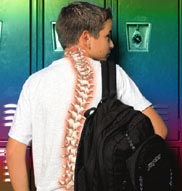 How much should a backpack weigh? What is the proper way of carrying it to avoid back injuries? Parents often complain, “My kid is having back pains, but we don’t know what’s causing it.” More often than not, improper backpack use and packing is the cause of such pains.
How much should a backpack weigh? What is the proper way of carrying it to avoid back injuries? Parents often complain, “My kid is having back pains, but we don’t know what’s causing it.” More often than not, improper backpack use and packing is the cause of such pains.
Backpack-related injury is a serious issue as more and more kids are developing spine problems at such a young age. It’s a growing concern between parents and health care professionals.
The developmental impact of an overloaded heavy backpack on a kid that is still growing is a lot more serious than people think. Long-term improper use of heavy backpacks causes curvature of the spine, muscle spasms, pinched nerves that lead to shoulder, neck and back problems in children that they carry into adulthood. It is also one of the leading causes of developing bad posture such as anterior or forward head posture, uneven shoulders, shoulder blades, and hips.
How can we avoid all of this? Here are a few tips: Warning signs that bag is too heavy
- Struggling when putting on or taking off the backpack.
- Change in posture when using the backpack — forward or side bending to compensate for heavy weight.
- Pain when carrying the backpack.
- Red marks on the shoulders.
- Tingling or numbness on shoulders and arms.
How to select the right backpack
- The right fit — it should fit in between the shoulder blade and top of the waist. A lot of kids have backpacks that are too big for their body size.
- Choose backpack with ergonomic design or features that make it more comfortable and easier to wear (shoulder padding to prevent straps from digging into the shoulder).
- Choose a backpack with a waist and chest belt — this way the backpack is more secure and the weight is distributed to the hips and away from the back.
- Look for multiple compartments for better organization and proper weight distribution. The proper way of carrying backpack • The suggested weight is 10-15 percent of the body weight for elementary to high school kids.
- Organize the backpack by putting the big, heavy books first, closest to your back. Remove books or other items that you won’t be using that day.
- Make sure the bottom of the bag is above the waistline by adjusting the shoulder straps. • Always carry backpack using both shoulder straps.
- Lift properly by standing in front of the backpack, bend at the knees, use both hands, and lift with your legs not your back, then strap onto shoulders.
 A factor worth mentioning, too, is the size and fitness level of your child. A bigger and stronger kid is able to handle more weight versus a small and petite kid; girls and younger children are usually at greater risk of developing back problems because they’re smaller. If your kid has scoliosis, this also warrants even more consideration.
A factor worth mentioning, too, is the size and fitness level of your child. A bigger and stronger kid is able to handle more weight versus a small and petite kid; girls and younger children are usually at greater risk of developing back problems because they’re smaller. If your kid has scoliosis, this also warrants even more consideration.
Kids don’t know how to communicate if something is wrong so subtle changes in your kid’s posture or behavior can go unnoticed. Don’t wait until your child begins to complain of pain. Spend a few minutes with your kids to evaluate and teach them the proper use and packing of their backpacks. In fact, this applies to everyone who uses a backpack, and not just to students. Nowadays, we bring our laptops, iPads, cameras, and other gadgets everywhere we go, so everyone can really benefit from this. A lot of the chronic aches and pains that adults feel stem from early, repetitive strains experienced during childhood that are ignored and left untreated.
Source: www.philstar.com; May 29, 2012.







